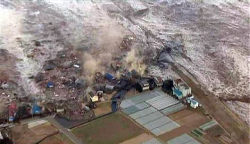
Unusual earthquake rupture pattern gave tsunami extra punch, writes Dwain Eldred
Geoscientist 21.06 July 2011
The Mw 9 earthquake and resulting tsunami that struck Japan on March 11 were like a one-two punch – first violently shaking, then swamping the islands, causing tens of thousands of deaths and hundreds of billions of dollars worth of damage. Stanford University researchers, writing in the journal Science Express, believe the catastrophe was caused by a sequence of unusual events never before seen so clearly.
"It was not appreciated before this earthquake that this size of earthquake was possible on this plate boundary" says Stanford geophysicist Greg Beroza. "It was thought that typical earthquakes were much smaller."
The fault on which the Tohoku-Oki earthquake took place dips to the west. It first ruptured to the west of its epicentre – 32km deep – toward the island of Honshu, shaking it violently for 40 seconds. The fault then ruptured east of the epicentre, unzipping backward and upwards toward the ocean floor, for about 30 or 35 seconds.
As the rupture neared the seafloor, the movement of the fault grew rapidly, violently deforming seafloor sediments lying above the fault plane, raising the overlying water column and triggering the tsunami.
"When the rupture approached the seafloor, it exploded into tremendously large slip," says Beroza. "It displaced the seafloor dramatically. This amplification of slip near the surface was predicted in computer simulations of earthquake rupture, but this is the first time we have clearly seen it occur in a real earthquake.
"The depth of the water column there is also greater than elsewhere" Beroza told Geoscientist. "That, together with the slip being at its greatest where the fault meets the ocean floor, led to the tsunami being outlandishly big."
"Now that this slip amplification has been observed in the Tohoku-Oki earthquake, what we need to figure out is whether similar earthquakes – and large tsunamis – could happen in other subduction zones around the world," he says. Beroza believs the sort of "two-faced" rupture seen in the Tohoku-Oki earthquake has not been seen in other subduction zones; though that could reflect limitations of the data.
Japan boasts a denser network of seismometers than anywhere else in the world, which provided the researchers with much more detail than is normally available after an earthquake, thus enabling them to discern the different phases of the March 11 quake with much greater resolution than usual.
Reference:
Shallow Dynamic Overshoot and Energetic Deep Rupture in the 2011 Mw 9.0 Tohoku-Oki Earthquake Satoshi Ide, Annemarie Baltay, and Gregory C Beroza. Science 20 May 2011: 911 Science DOI: 10.1126/science.1207020.